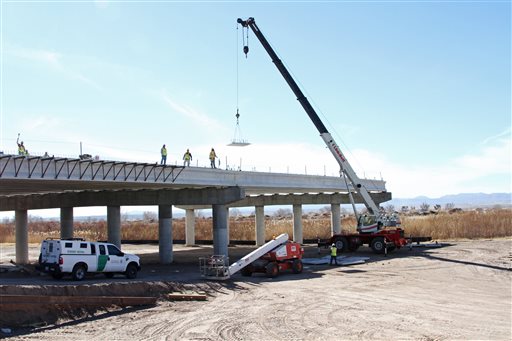(AP) Building of new US-Mexico border crossing stalls
By JUAN CARLOS LLORCA
Associated Press
TORNILLO, Texas
Jesse Grado walks cautiously past a welder whose work throws off a spray of brilliant sparks as construction crews lay slabs of concrete for a bridge over the Rio Grande. The leader of the project points to an empty void _ the point where the six-lane span abruptly ends 30 feet above the river.
Beyond the pavement is nothing but miles of Mexican farms, dirt and desert.
By June, this was supposed to be the site of a massive new customs-and-immigration facility that would provide a fourth international border crossing to handle U.S.-bound commercial traffic from Ciudad Juarez, one of North America’s biggest manufacturing hubs.
Planners had hoped the $96 million undertaking would be an economic boon, attracting manufacturing plants and long lines of trucks that currently use two congested crossings between Ciudad Juarez and El Paso.
But nearly two years after a ceremonial groundbreaking, not a shovel of dirt has been moved south of the border. The Mexican government has not allocated any money for its share of the work, so the bridge building is stalled _ with no timetable for completion.
In the meantime, truckers say they won’t be lured away from the established crossings until this remote farmland draws more industry. That could take years.
Truckers hauling cargo from Ciudad Juarez say using the bridge would require them to make an hour-long drive east to the new crossing then spend another hour traveling back to cargo terminals in El Paso, Texas, to unload.
So far, the border community of Tornillo has secured no agreements with industry. For now, it offers little but fields of cotton and alfalfa. The scene is similar across the river in the tiny town of Guadalupe, Mexico.
Still, local officials hope that by building the crossing first, commercial traffic will come later. They cite the success at the Santa Teresa port of entry, which was built 20 years ago in New Mexico in a similarly remote area.
About 15 years after the crossing opened, a huge industrial park that houses manufacturing giant Foxconn was built a few hundred yards from the inspection stations. It has since attracted more businesses.
The two farming communities have been pushing for the Tornillo-Guadalupe international bridge for the last 16 years to replace a 1920s-era wooden bridge. Once the new span is finished, the federal government plans to transfer customs and immigration personnel to the adjoining 117-acre complex.
In July 2011, American and Mexican officials showed up with golden shovels and delivered speeches about the promising future for the surrounding communities. Cesar Duarte, governor of the Mexican state of Chihuahua, pledged that construction would start two months later.
The Mexican Department of Transport and Communications blames the delay on national elections that installed new leadership in late 2012. There is still no budget for the Mexican portion of the crossing, which would cost more than $15 million.
The U.S. State Department, in charge of the American side of the project, acknowledged the delay but referred all other questions to the Mexican government.
Once complete, the bridge will serve the same function as the five other border crossings in the Ciudad Juarez area, which currently process more than 10 million cars, 700,000 trucks and 6 million pedestrians every year.
But exactly how much traffic would be diverted to Tornillo is anyone’s guess.
Most Mexican trucking companies are not allowed to venture more than 25 to 50 miles into the U.S. _ a rule that requires them to use drop-off points closer to the border. No one knows how long it will take to entice those kinds of cargo terminals to the Tornillo area, or if a federal pilot program allowing Mexican trucks to drive deeper into the U.S. could be expanded.
Escobar said she expects many farmers pressed by drought to sell their land to industrial developers. A few “for sale” signs have already popped up around the area.
When the port of entry was first inaugurated in 1993 in southeastern New Mexico, the paved road ended abruptly at the Mexican border. Five years passed before the Mexican government paved the 12-mile stretch that led to Ciudad Juarez and another decade before it landed the industrial park.
The Chihuahua governor hopes the bridge expansion on the Mexican side will make it an ideal spot for factories.
Until that happens, truckers say they would rather wait in line at the congested crossings than make the long drive from Ciudad Juarez to Tornillo and back up to El Paso. The typical wait time at the existing bridges is two hours.
The new crossing “does not make much sense unless you see it in the very long term,” truck driver Hector Mendoza said while taking a break at a truck terminal in El Paso.
Raul Lara concurred, saying the trip to Tornillo could actually cost more and take just as much time.
Neither the location debate nor the construction delay is having much effect on Grado, who oversees the work crews on the U.S. side. They aim to have their part of the project finished on time.

COMMENTS
Please let us know if you're having issues with commenting.